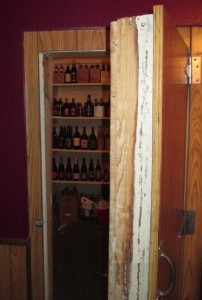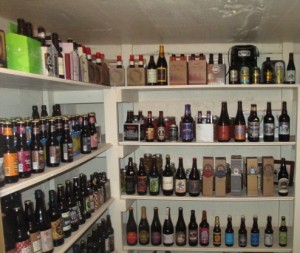
I started cellaring beer approximately 2 years ago. One of my main goals with cellaring was to set up vertical tastings. A vertical tasting is where you drink vintages of the same beer to determine a sweet spot for aging that beer. Another reason I started cellaring is because I started obtaining beer faster than I could consume it. Living in Wisconsin, we are blessed with having clear seasons throughout the year and big heavy beers, especially stouts, are really most enjoyable for me during those cold winter months. I want to outline some best practices that I live by for cellaring. Because not everyone has ideal conditions for cellaring, just do the best with what you’ve got!
What kind of beers can I cellar?
• In general, any beer over 9% ABV will have some longevity: Imperial Stouts, Barleywines, Quads, Wee Heavys, Ole Ales, etc.
• The only exception is Double IPAs. Hops begin to fall off dramatically after a couple of months so don’t waste your beer or time
• Beers that use souring yeast strains at any ABV are also ideal for cellaring. Brett only beers tend to have less progession. Beers that use multiple sour strains such as brett, pedio, and lacto will age nicely
• Beers with prominent coffee flavors DO NOT age well, coffee flavor tends to fade away pretty quickly leaving gaps in the flavor profile
How long do I cellar?
• In general, stouts tend to age favorably for 2 and sometimes up to 5 years, but not often beyond that
• Other high ABV beers that don’t have quite the layers of complexity such as barelywines are typically able to be cellared for 5+ years
• Sours provide the greatest opportunity for long term cellaring. Up to 7 and even 10 years is not out of the question
What conditions do I cellar my beer? Since everyone lives in different parts of the world, I wanted to provide guidelines to strive for when cellaring beer
• Ideal temperatures for cellaring are in the 50-55 degree range. Warmer temperatures will accelerate the maturation process, while colder temperatures will slow the progression
• Because it is very difficult for most of us to hit this temperature throughout the year, it is even more important to find a spot that doesn’t have a lot of temperature fluctuations
• Gradual temperature changes throughout the year are less detrimental than frequent or drastic changes.
• Make sure you find a spot that is dark and void of excess moisture
• Always store beer standing up and not on the side
• Basements make an ideal location for cellars because they are underground and tend to have less temperature change throughout the year
• You can use a fridge, but keep note of the temperature. If too cold, you can really hault the aging process
• If you don’t have a basement, use a closet that you don’t often access. You can take further precautions by storing your bottles in a box to keep them out of the light
• When picking a closet, find a cooler part of the house that doesn’t have vents nearby
For me, cellaring beer is just a way for me to further enhance my beer drinking experience. Whether any amount of time makes a beer better or worse is all in the eyes of the person drinking the beer. In the end, I always encourage people to do whatever makes their experience the absolutely most enjoyable.

Pingback: Which Trappist Quad Will You Choose? | HereForTheBeer.com